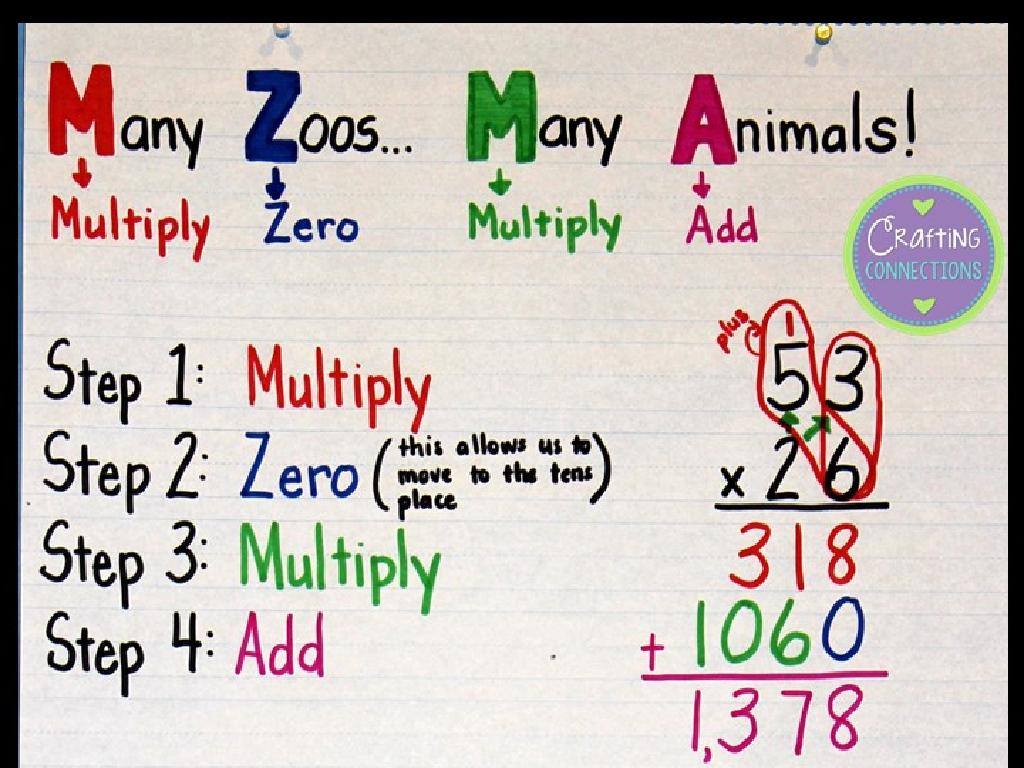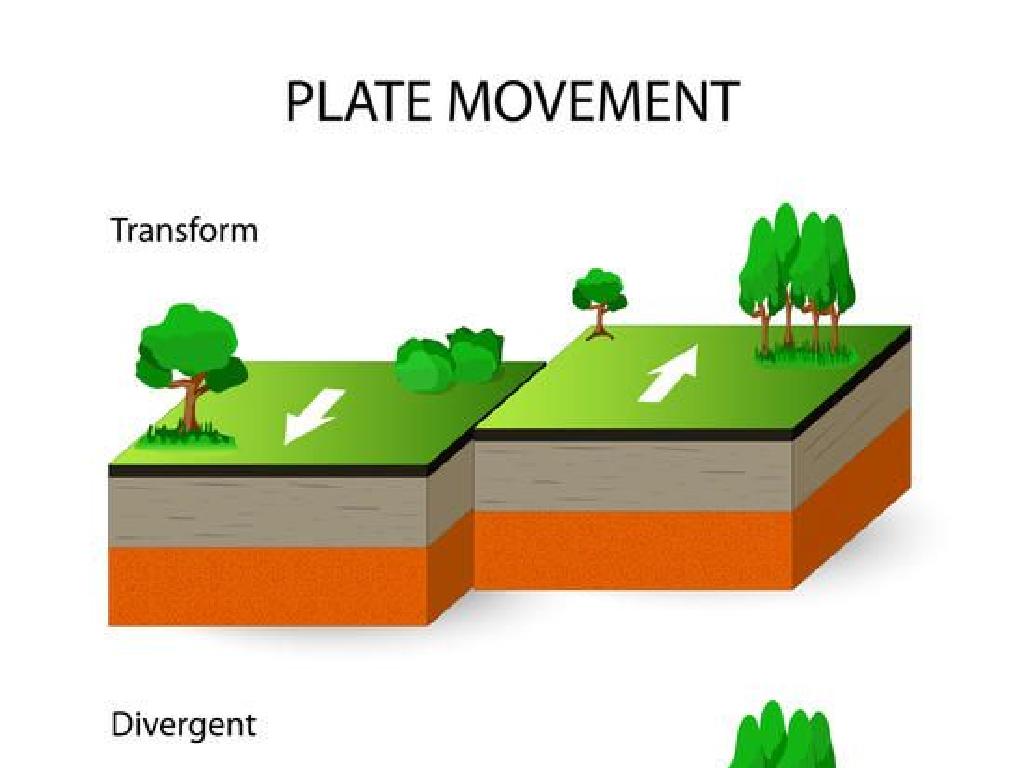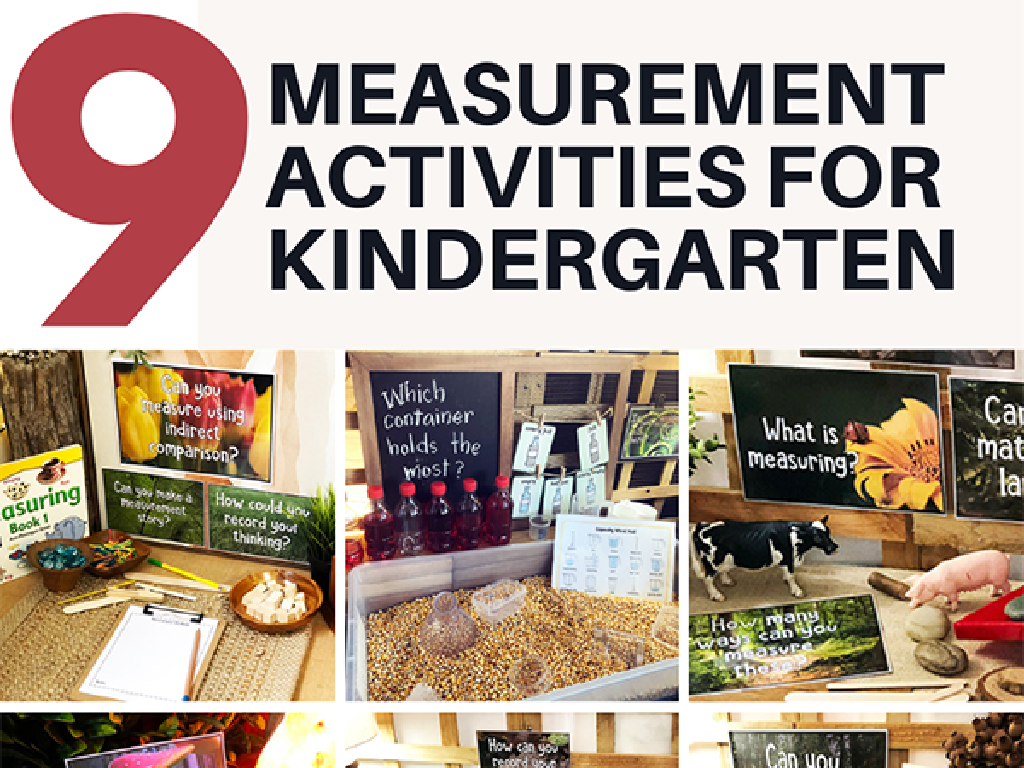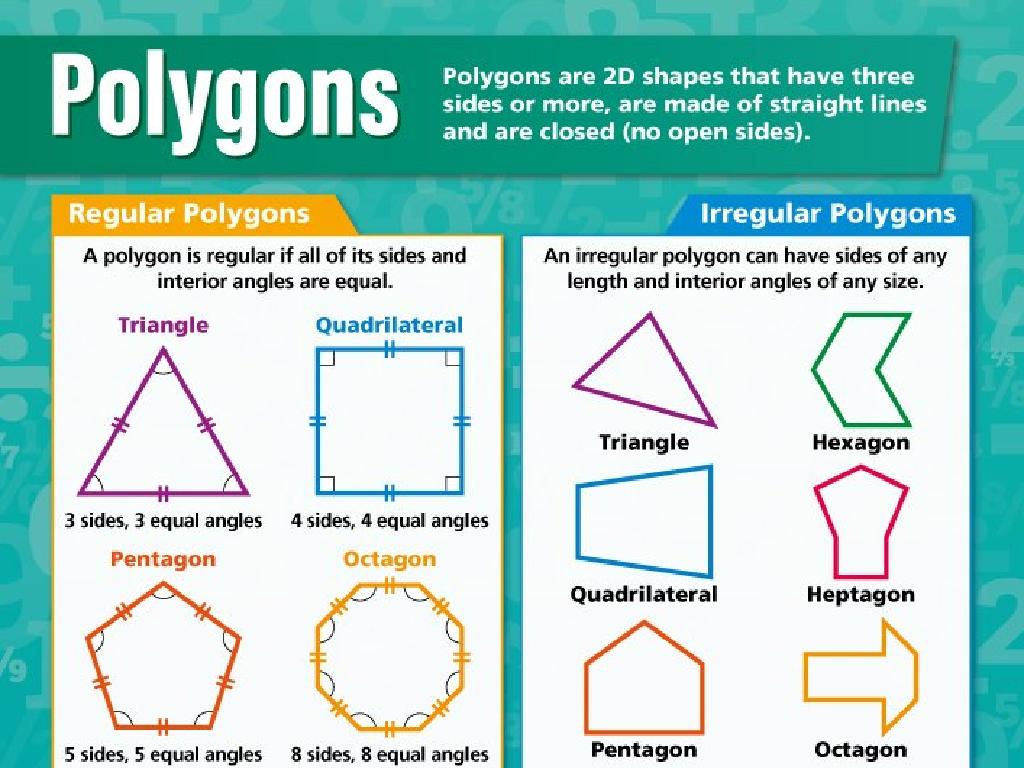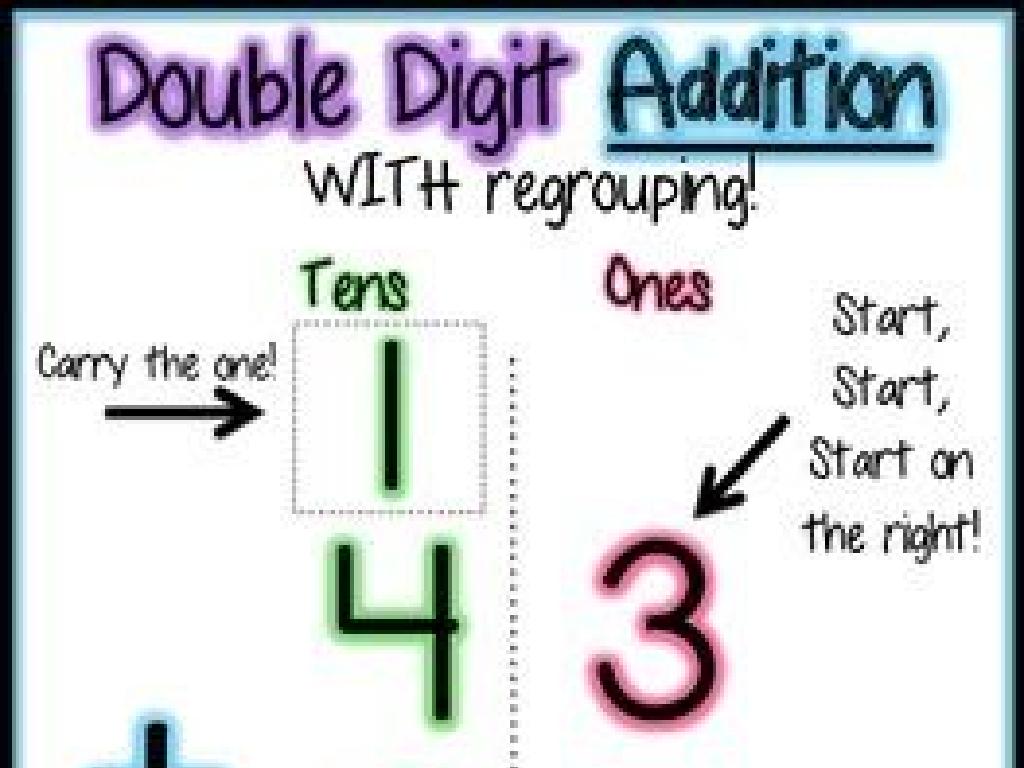Form The Progressive Verb Tenses
Subject: Language arts
Grade: Fifth grade
Topic: Verb Tense
Please LOG IN to download the presentation. Access is available to registered users only.
View More Content
Forming Progressive Verb Tenses
– Verbs show time and action
– Verbs can tell us when an action is happening: past, present, or future.
– Importance of verb tenses
– Using the correct tense helps us understand when events occur.
– Structure of progressive tenses
– Progressive tenses use ‘to be’ verbs + verb-ing, like ‘am eating’ or ‘was running’.
– Examples in daily communication
– ‘I am learning’ shows action happening now, ‘She was singing’ shows past action.
|
This slide introduces the concept of progressive verb tenses to fifth graders, emphasizing the role of verbs in indicating the timing of actions. It’s crucial to explain that verb tenses help us understand when something happens, making our communication clear. Discuss the structure of progressive tenses, highlighting the use of ‘to be’ verbs followed by the present participle (verb-ing). Provide relatable examples that students encounter in everyday conversation to illustrate the use of progressive tenses in context. Encourage students to think of their own examples and to be mindful of verb tenses when speaking and writing.
Understanding Progressive Verb Tenses
– Review: What are verb tenses?
– Verb tenses show when an action occurs
– Verb tenses indicate action timing
– They tell us if an action is ongoing or completed
– Examples: Past, Present, Future
– Past (was walking), Present (am walking), Future (will be walking)
– Focus: Forming Progressive Tenses
– Progressive tenses show ongoing actions at different times
|
Begin with a quick review of verb tenses to ensure students recall that verb tenses communicate the timing of an action. Emphasize that verb tenses allow us to express whether something happened in the past, is happening right now, or will happen in the future. Provide clear examples for each tense using the same action verb to illustrate the differences. Then, introduce the concept of progressive verb tenses, which specifically highlight actions that are currently in progress. Use relatable activities and encourage students to form sentences using progressive tenses to describe actions they often do. This will help them grasp the concept of ongoing actions in different time frames.
Understanding Progressive Verb Tenses
– What does ‘progressive’ mean?
– Shows ongoing action
– Like a movie still playing, not finished
– Formed with ‘to be’ + verb ending in -ing
– ‘Am’, ‘is’, ‘are’ + playing, running, reading
– Examples in sentences
– ‘I am learning’, ‘She is singing’, ‘They are walking’
|
This slide introduces the concept of progressive verb tenses to fifth graders. Progressive tense is used to indicate actions that are currently ongoing or in progress. It’s formed by combining the helping verb ‘to be’ with the present participle of the main verb, which always ends in -ing. For example, ‘I am running’ or ‘He is eating’. It’s like capturing a moment in a movie that’s still playing. The slide provides a foundation for understanding how to form and use the progressive tense, which will be further practiced with examples and exercises in class.
Present Progressive Tense
– Used for current actions
– Structure: am/is/are + verb-ing
– ‘am’ for I, ‘is’ for he/she/it, ‘are’ for you/we/they
– Example: I am reading
– ‘I am reading a book about tigers’ shows action happening now
– Practice forming sentences
– Use objects around you to make sentences in present progressive
|
The present progressive tense is used to describe actions that are happening at the moment of speaking. It is formed with the appropriate form of ‘to be’ (am/is/are) followed by the base verb with an ‘-ing’ ending. For example, ‘I am reading’ indicates the speaker is currently in the process of reading. It’s important to ensure students understand the correct form of ‘to be’ for each subject pronoun. Provide students with various verbs and have them practice creating sentences in the present progressive tense using items in the classroom or their immediate environment to make the learning process interactive and engaging.
Understanding Past Progressive Tense
– Used for ongoing past actions
– Like reading a book yesterday evening
– Structure: was/were + verb-ing
– ‘Was’ for ‘I/he/she/it’, ‘were’ for ‘you/we/they’
– Example: She was singing
– Imagine she continued singing despite the interruption
– Recognize past progressive in sentences
– Find sentences using ‘was/were’ followed by a verb ending in ‘-ing’
|
The past progressive tense is used to describe actions that were happening at a specific moment in the past. It’s formed with ‘was’ or ‘were’ plus a verb ending in ‘-ing’. For example, ‘She was singing when the phone rang’ tells us that the action of singing was in progress when another action occurred. Encourage students to think of actions they were doing yesterday and how they would describe them using the past progressive tense. Have them practice forming sentences with both ‘was’ and ‘were’ to ensure they understand the correct usage based on the subject. Also, ask them to identify past progressive tense in sentences from a story or their reading book.
Future Progressive Tense
– Expresses ongoing future actions
– Formed with will be + verb-ing
– Example: Future travel plans
– ‘They will be traveling to France next summer’ shows plans
– Usage in setting scenes
– Often used in storytelling to set the stage for future events
|
The future progressive tense is used to describe actions that will be happening at a specific time in the future. It’s a way to talk about ongoing or continuous activities that will occur. Teach students the structure ‘will be + verb-ing’ to form this tense. Use the example of a future travel plan to illustrate how this tense can be used to describe what someone will be doing. Highlight that this tense is also useful in storytelling, as it helps to set the scene for events that will unfold. Encourage students to practice by forming sentences about their own future plans or by creating stories that include future progressive tense.
Let’s Practice Together: Progressive Verb Tenses
– Interactive progressive tense practice
– I’ll say a sentence; you make it progressive
– Example: I (to read) a book about tigers.
– Change to: I am reading a book about tigers.
– Your turn to form progressive sentences!
– Think about what’s happening right now.
|
This slide is designed for an interactive class activity to practice forming progressive verb tenses. Start by explaining that progressive verb tenses show ongoing actions. Then, provide a sentence and ask the students to convert it into the progressive tense. Use the example provided to demonstrate how ‘to read’ changes to ‘am reading’ to indicate the action is in progress. After the example, encourage students to form progressive tenses with new sentences. Possible activities: 1) Pair students to practice with each other. 2) Have a volunteer come to the board to write their sentence. 3) Create a game where students race to form correct progressive sentences. 4) Use flashcards with verbs. 5) Role-play with sentences to act out the progressive actions.
Your Turn to Form Progressive Tenses
– Convert sentences to progressive
– ‘She (to walk) to school every day.’
– Change to ‘She is walking to school today.’
– ‘They (to eat) dinner when the show started.’
– Change to ‘They were eating dinner when the show started.’
– Use ‘is’, ‘are’, ‘was’, or ‘were’
– These words help form the progressive tense.
|
This activity slide is designed to help students practice forming progressive verb tenses. Progressive tenses show ongoing actions. Start by explaining the structure of the progressive tense: subject + ‘to be’ verb (is, are, was, were) + present participle (verb ending in -ing). Then, guide students through converting the provided sentences into the progressive tense. For example, ‘She walks to school every day’ becomes ‘She is walking to school today.’ This indicates the action is happening now. Similarly, ‘They eat dinner when the show started’ changes to ‘They were eating dinner when the show started,’ indicating the action was happening at that past moment. Encourage students to think about the time frame of each sentence to choose the correct form of ‘to be.’
Class Activity: Verb Tense Charades
– Understand progressive verb tenses
– Act out actions silently
– Mimic an activity without speaking
– Classmates guess in progressive tense
– Respond with sentences like ‘He is running’ or ‘She is jumping’
– Use sentences like ‘You are swimming!’
|
This activity is designed to reinforce the students’ understanding of progressive verb tenses in a fun and interactive way. The teacher will explain that progressive verb tenses describe ongoing actions. Students will take turns acting out different actions while the rest of the class tries to guess the action using the correct progressive tense. For example, if a student is pretending to read, the classmates might guess by saying ‘You are reading!’. The teacher should prepare a list of verbs for the students to act out and ensure that each student gets a turn. The teacher can also participate to model the activity. It’s important to correct any mistakes gently and provide positive feedback to encourage participation.
Wrapping Up: Progressive Verb Tenses
– Congratulations on learning progressive tenses!
– Progressive tenses indicate ongoing actions
– Actions that are currently happening or continuous
– Homework: Craft 5 sentences with progressive tenses
– Include present, past, and future progressive tenses
– Use different progressive tenses for each sentence
– Example: I am reading, I was reading, I will be reading
|
Students have now learned about the progressive verb tenses, which are used to describe actions that are in progress at the moment of speaking, were in progress in the past, or will be in progress in the future. For homework, they should write five sentences, each illustrating a different progressive tense. This exercise will help reinforce their understanding of how to form and use the progressive tenses in various contexts. Encourage creativity and the use of a mix of subjects and verbs to ensure a comprehensive grasp of the material. In the next class, review the homework to correct any misunderstandings and praise correct usage.

